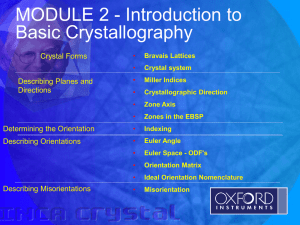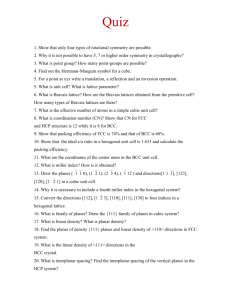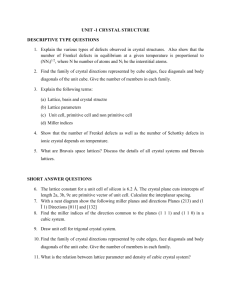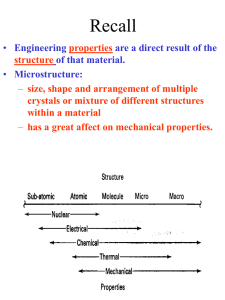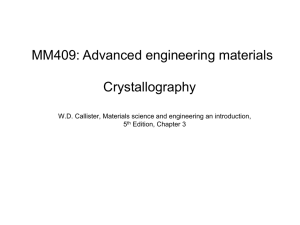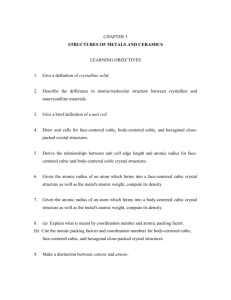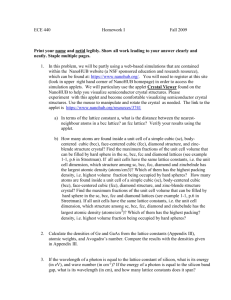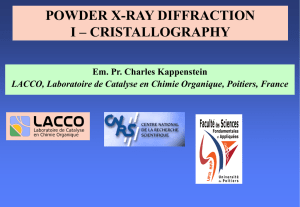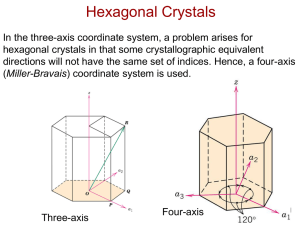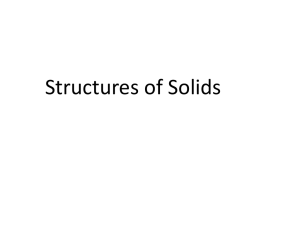Crystalline Structure
advertisement
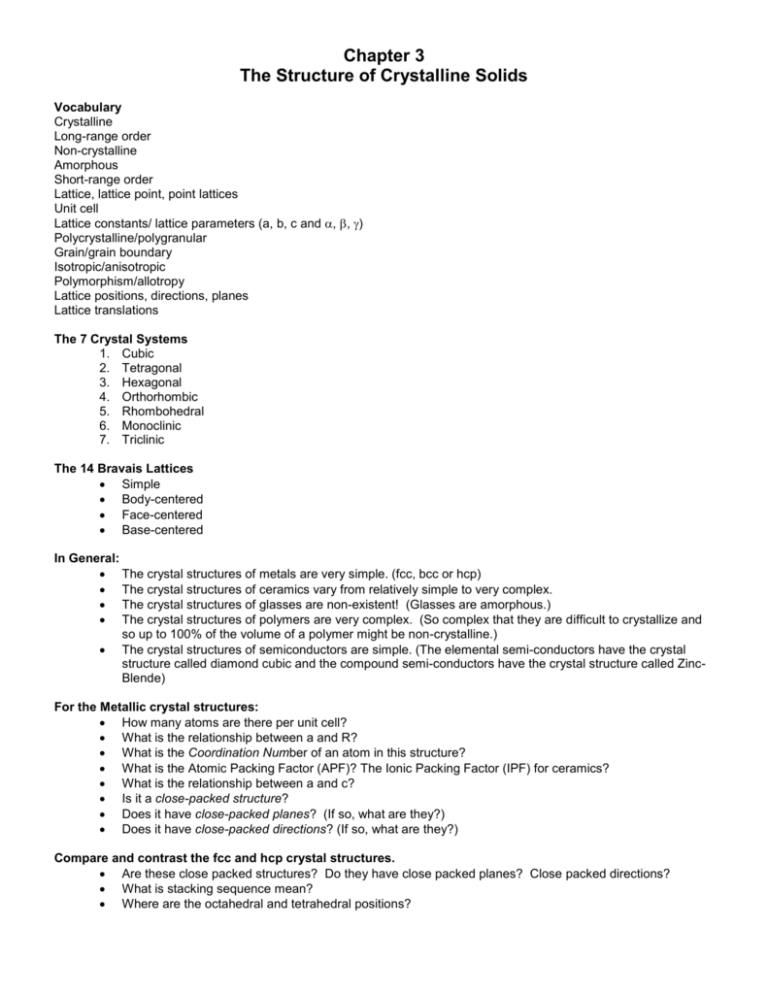
Chapter 3
The Structure of Crystalline Solids
Vocabulary
Crystalline
Long-range order
Non-crystalline
Amorphous
Short-range order
Lattice, lattice point, point lattices
Unit cell
Lattice constants/ lattice parameters (a, b, c and , , )
Polycrystalline/polygranular
Grain/grain boundary
Isotropic/anisotropic
Polymorphism/allotropy
Lattice positions, directions, planes
Lattice translations
The 7 Crystal Systems
1. Cubic
2. Tetragonal
3. Hexagonal
4. Orthorhombic
5. Rhombohedral
6. Monoclinic
7. Triclinic
The 14 Bravais Lattices
Simple
Body-centered
Face-centered
Base-centered
In General:
The crystal structures of metals are very simple. (fcc, bcc or hcp)
The crystal structures of ceramics vary from relatively simple to very complex.
The crystal structures of glasses are non-existent! (Glasses are amorphous.)
The crystal structures of polymers are very complex. (So complex that they are difficult to crystallize and
so up to 100% of the volume of a polymer might be non-crystalline.)
The crystal structures of semiconductors are simple. (The elemental semi-conductors have the crystal
structure called diamond cubic and the compound semi-conductors have the crystal structure called ZincBlende)
For the Metallic crystal structures:
How many atoms are there per unit cell?
What is the relationship between a and R?
What is the Coordination Number of an atom in this structure?
What is the Atomic Packing Factor (APF)? The Ionic Packing Factor (IPF) for ceramics?
What is the relationship between a and c?
Is it a close-packed structure?
Does it have close-packed planes? (If so, what are they?)
Does it have close-packed directions? (If so, what are they?)
Compare and contrast the fcc and hcp crystal structures.
Are these close packed structures? Do they have close packed planes? Close packed directions?
What is stacking sequence mean?
Where are the octahedral and tetrahedral positions?
Crystallographic Positions
Lattice positions are designated as fractions or multiples of unit cell dimensions. No commas, no parentheses: ½ ½ ½
is the center of a unit cell. Structurally equivalent positions are connected by lattice translations, consisting of integral
multiples of lattice constants along directions parallel to the crystallographic axes.
Crystallographic Directions
[u v w ]
This represents an individual direction in the cubic system.
u, v, w are direction indices for the cubic system.
Negative signs are placed on top of the number.
They are the vector components reduced to smallest integers measured in terms of the unit
cell dimensions a, b and c.
<u v w >
This indicates a family or form of directions that are all structurally equivalent.
[u v t w]
This is an individual direction in the hexagonal system.
u, v, t, w are Miller-Bravais indices for the hexagonal system. (u + v = -t)
<u v t w>
This indicates a family or form of directions that are all structurally equivalent in the hexagonal
system.
Crystallographic Planes
(h k l)
This represents an individual plane in the cubic system.
h, k, l are called Miller indices for the cubic system.
They are the reciprocals of the axial intercepts reduced to smallest integers.
{h k l}
This indicates a family or form of planes that are all structurally equivalent.
(h k i l)
This is an individual plane in the hexagonal system.
h, k, i, l are Miller-Bravais indices for the hexagonal system. (h + k = -i)
{h k i l}
This indicates a family or form of planes that are all structurally equivalent.
Linear Density1
=
number of atoms along the specified direction in the u.c.
length of the line in the u.c. along the specified direction
Repeat Distance, r = (if atoms are uniformly spaced along given direction) reciprocal of linear density.
Planar Density = number of atoms whose centers are in the specified plane in the u.c.
area of the plane in the u.c.
For the Cubic System:
[h k l] (h k l)
a
d hkl
directions with same indices without regard to order or sign are equivalent
planes with the same indices, irrespective of order and sign are equivalent
the angle between two directions can be obtained by the dot product
=
h k2 l2
2
1
These are alternative definitions for linear and planar density:
Linear Density = length occupied by atoms whose centers are in the specified direction in the u.c.
length of the line in the u.c.
Planar Density = area occupied by atoms whose centers are in the specified plane in the u.c.
area of the plane in the u.c.
Some simple ceramic crystalline structures:
o sodium chloride structure (NaCl)
o
cesium chloride structure (CsCl)
o
zinc blende structure (ZnS and Compound Semiconductors)
o
fluorite structure (CaF2) – UO2 is a reactor fuel that can accommodate fission products without troublesome
swelling due to the unoccupied volume near the center of this unit cell.
o
perovskite structure (CaTiO3) - Ba TiO3 is an important ferroelectric and piezoelectric material. High
temperature superconductors result from variations in the structure of these types of ceramics.
o
Diamond Cubic structure (Carbon and Elemental Semiconductors)
o
graphite (Carbon)
o
fullerenes (C60) –astrophysics research discovered the unique molecular-scale version of the geodesic dome:
the buckminsterfullerene or buckyball. Cn are unique passive surfaces on a nm-scale and bucky tubes have
potential use as high strength fibers for composites. Capturing metal ions within Cn cages makes a
superconductor. Clearly an intriguing material.
o
cristobalite structure (SiO2) – Silica, alone, and in combination with other ceramic oxides (forming silicates),
represent a large fraction of the ceramic materials available.
o
corundum structure (Al2O3)
o
spinel structure (MgAl2O4)/Inverse Spinel – ferrites or ferromagnetic ceramics are in this category.
o
kaolinite structure [2(OH)4Al2Si2O5] – a hydrated aluminosilicate clay mineral. The structure is typical of sheet
silicates.
Some simple semiconductor crystalline structures:
o
diamond cubic structure (elemental semiconductors)
o
zinc-blende structure (III-V or II-VI compound semiconductors)
o
wurtzite structure – energetically very close to zinc blend
Some not so simple polymeric crystalline structures:
o
polyethylene – long-chain molecule folds back and forth on itself. Orthorhombic unit cell.
o
polyhexamethylene adipamide (nylon 66)
X-Ray Diffraction
X-ray diffraction is a tool that reveals the crystal structure of material. It can be used to determine the structure of a
new material, or the known structure of a common material can be used as a source of chemical identification.
Diffraction is the result of radiation being scattered by a regular array of scattering centers whose spacing is about the
same of the wavelength of the radiation. Atoms and ions are on the same order of the wavelength of x-radiation.
Hence, they can be used to scatter x-rays and the pattern of diffraction is used to characterize the crystalline structure.
A crystal acts as a 3-dimensional diffraction grating.
